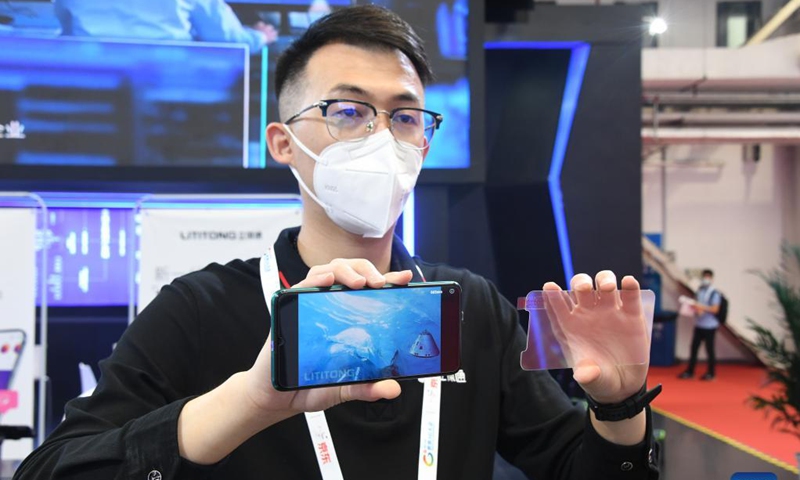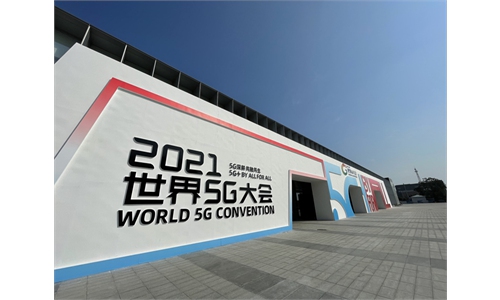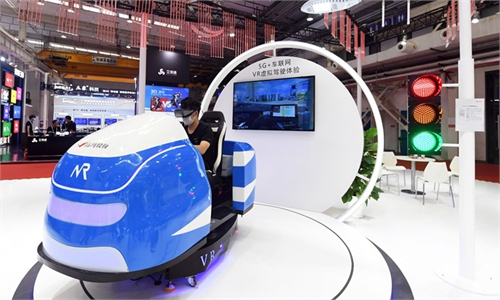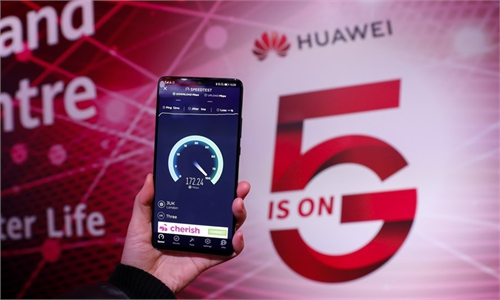
A staff member displays a mobile phone screen film that can generate 3D vision with phone applications during the 2021 World 5G Convention in Beijing, capital of China, Aug. 31, 2021. The 2021 World 5G Convention kicked off here on Tuesday. Photo: Xinhua
There are 10,000 projects exploring business-to-business (B2B) applications of 5G (5GtoB) around the world, and more than half them are in China, a senior executive of Huawei said on Wednesday, calling for the industry to focus on XR, the B2B market and low-carbon development in the 5G era.
The comments, made by rotating chairman Ken Hu Houkun at Huawei's 12th annual Global Mobile Broadband Forum (MBBF) held in Dubai, showcased China's pioneering practices in 5G applications while others are still haunted by epidemic woes. They also demonstrated Huawei's ambition to further lead the mobile industry amid a US crackdown, industry analysts told the Global Times on Wednesday.
"In just five years of commercial deployment, 5G has provided a considerable upgrade in mobile experience for consumers, and it's already starting to empower different industries around the globe. Progress was much faster than we expected," Hu said in a keynote speech at the forum.
According to a statement the firm sent to the Global Times, there are 176 commercial 5G networks around the globe, serving more than 500 million subscribers. In the consumer space, average 5G download speeds are roughly 10 times faster than 4G, which has fueled broader adoption of applications like virtual reality and 360º broadcasting.
In the enterprise space, there are already 10,000 projects exploring B2B applications of 5G around the world. 5G applications in industries such as manufacturing, mining, and ports have already passed trials and are being replicated at scale.
While progress has been steady, Hu noted that there are still some areas for improvement. "Right now, more than half of these 10,000 5GtoB projects are in China. We have a huge number of use cases already, but we need to build more sustainable business cases."
Hu outlined three areas of opportunity that will drive the next stage of 5G growth, including XR services, the B2B market, and low-carbon development. Hu called on the ICT Industry to work together on the next stage of 5G development.
The firm has been facing a severe US crackdown for years, which has strangled its revenue-making businesses such as smartphones, and forced it to move to other sectors that could take advantage of its 5G capabilities and empower the digital transformation of industries.
Following a unit for technologies in coal mining that was established earlier this year, the company has expanded its footprint into four new areas - customs and ports, smart highways, data centers and solar energy - by setting up new "corps" on Monday, media reports said, citing a document published on Huawei's internal employee community platform.
Huawei's 5G technology is still at least one to two years ahead of its rivals, but it also has to expand channels to "make money" that could allow it to maintain that lead amid the US' crackdown, Xiang Ligang, director-general of the Beijing-based Information Consumption Alliance, told the Global Times.



